Are you unsatisfied with the quality of your water? Wondering how you can improve your water quality? Then you’re in the right place!
There are a number of different things you can do to improve the quality of your water. We’re going to discuss the most prominent of these things in detail below. Let’s go!
1. Have Your Plumbing Inspected
One of the keys to maintaining the quality of your water is to have your plumbing inspected on a regular basis. Why is this important? Because, over time, plumbing can deteriorate, causing plumbing materials to permeate the water that passes through it.
Most plumbing pipes are made out of steel or copper. As such, once your plumbing starts to deteriorate, one of these substances is bound to end up in the water that you’re drinking.
But by having your plumbing inspected by a professional, you can ensure that the levels of these materials are kept to a minimum. Your plumber will inform you as to how much your plumbing is affecting your water. When necessary, he or she will advise you to replace certain components within your plumbing system.
2. Install a Water Softener
Depending on where you live, you could have hard water running through your pipes. Hard water is essentially just water with high calcium and magnesium content.
It’s not unsafe to drink but can impair the functionality of both plumbing systems and water-based appliances. Not to mention, it can dry out the skin and the hair. As such, if you’re dealing with hard water, you would be best served by getting rid of it.
How do you do so? It’s as simple as installing a water softener. A water softener will remove the calcium and magnesium from your water, making it soft water, and allowing it to be as functionally beneficial as possible.
If you’re interested in installing a water softener, you’re advised to call up a water conditioning company. They’ll install your water softener in the correct manner, ensuring that everything is operating as intended.
3. Install a Reverse Osmosis System
If your goal is to establish a steady stream of highly purified drinking water, you should consider installing a reverse osmosis system. Reverse osmosis systems are designed to remove almost all of the contaminants from a water supply. In doing so, they make water as clean and as drinkable as possible.
Reverse osmosis systems are generally small enough to keep under your kitchen sink. You just hook them up to their respective water lines and let them work their magic throughout the day.
These systems remove not only minerals and chemicals but bacteria as well. The best rated reverse osmosis system? There are many candidates competing, but the AquaTru Reverse Osmosis Water System appears to be second to none. As such, they produce the safest drinking water imaginable.
4. Replace Your Water Aerators
If you’re not familiar, a water aerator is a little mesh screen that sits on the end of a faucet. It essentially acts as a final filter for the water system, helping to clean up the water before it’s consumed or used.
Unfortunately, over time, minerals and other contaminants can build up on the aerator, leading to contamination. As such, to prevent this from happening, you need to replace your aerators every few months or so. Generally speaking, twice-yearly changes will suffice.
Don’t worry: this isn’t expensive. You can buy a new aerator for under $5.00. Some
are as cheap as a dollar.
5. Make Use of Chemical Injection Systems
If you get your water from the city supply, a good many potential contaminants could already be eradicated from it. Unfortunately, if you get your water from a private well, you’re probably going to have to deal with these contaminants yourself.
How do you do this? The answer is as simple as installing chemical injection systems. These systems will neutralize the contaminants contained within the water supply, making the water safe for consumption and functional for non-drinking purposes.
Curious as to the contaminants that are removed by a chemical injection system? They include iron, manganese, hydrogen sulfide, and bacteria.
6. Drain Your Water Heater
It’s not just your pipes that can impair the quality of your water; your water heater can do the same. As such, in order to maintain the high quality of your water, you need to drain your water heater from time to time. By doing so, you’ll remove sediment and bacteria existing within the water heater, ensuring that it doesn’t end up in your water.
Fortunately, draining a water heater is fairly simple. Just follow the steps contained within the aforementioned link and you should be good to go.
How often should you drain your water heater? At least once a year, though twice a year is really the ideal.
7. Boil Your Water
Let’s say you don’t have the money to be spending on high-quality water conditioning systems. What can you do in a pinch to ensure that your water is relatively clean? You can boil it!
Boiling water removes the bacteria that exist within it, ensuring that it’s safe for consumption. This is why municipalities will sometimes issue “boil warnings”. The local water was found to contain a potentially toxic contaminant, one which could cause serious health issues if not boiled out.
Now, be sure, boiling your water won’t remove all of the contaminants contained within it. All of the minerals will remain. That said, it will kill the toxic contaminants, and that’s good enough for drinking water purposes.
There are All Sorts of Things You Can Do to Improve Your Water Quality
As you can see, there are all sorts of things you can do to improve your water quality. Utilize the tips above and you’ll be drinking clean, delicious water in no time.
Seeking out similar info? Our website has you covered. Browse our selection of articles right now!
